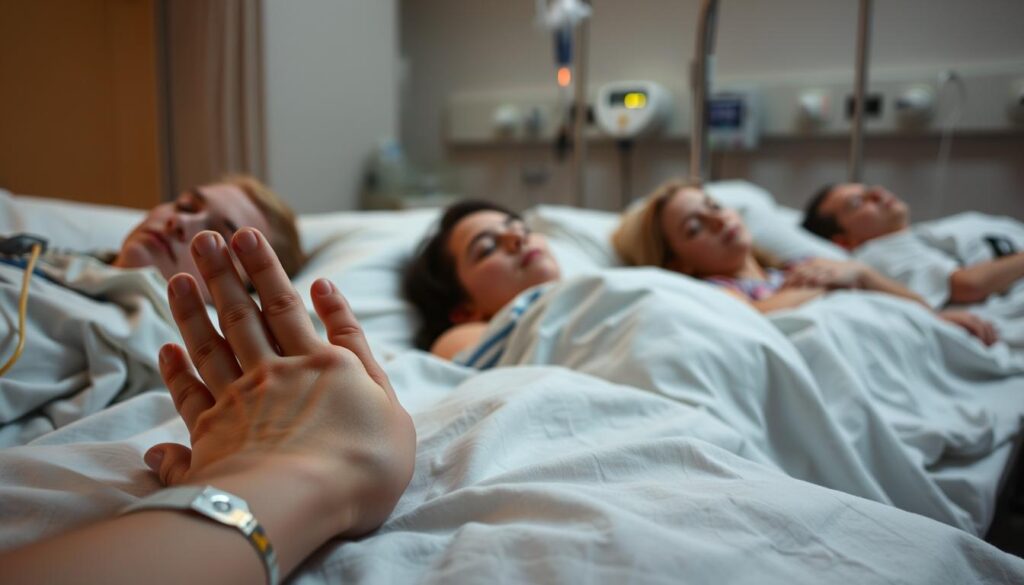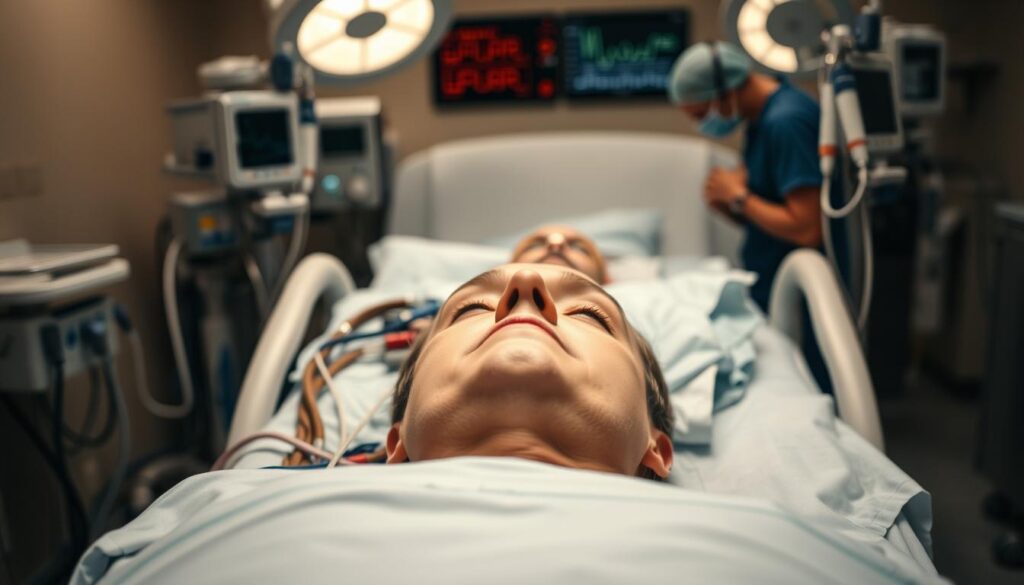Death seems like the end, but what if it’s not? Every year, thousands of people survive when their hearts stop. These cases challenge what we think about life and death.

The human body has limits, but some people go beyond them. Doctors in emergency rooms see patients whose hearts stopped for minutes or hours. Yet, they come back to share their stories. These tales are not just medical oddities; they give us hope and inspire new treatments.
Medical science now knows a critical time when people can be saved. This time is between when the heart stops and when cells start to die. It’s the key to understanding these survival miracles.
From people who drowned in cold water to those hit by lightning, to yogis who control their heartbeats, to patients who come back after being declared dead. These stories make us rethink what we know about death.
Key Takeaways
- Clinical death occurs when the heart stops beating, but doesn’t always mean permanent death
- There’s a critical window between heart stoppage and cell death where revival is possible
- Modern resuscitation techniques have dramatically increased survival rates
- Some individuals have survived after hours without a detectable heartbeat
- Near-death experiences are commonly reported by those who’ve survived clinical death
- Cold water drowning victims have higher survival rates due to the protective effects of hypothermia
- Medical understanding of death continues to evolve with each remarkable survival case
Understanding the Phenomenon of Surviving Clinical Death
The human body is incredibly resilient. It often surprises us by bouncing back when we least expect it. The line between life and death is not as simple as we think. It’s more like a spectrum where life can be revived.
The Difference Between Clinical and Biological Death
When we discuss clinical vs biological death, we’re talking about two important states. Clinical death happens when the heart stops and breathing stops, but the cells can still live. This is a chance for revival, lasting only minutes.
Biological death is when cells start dying for good, making it impossible to come back. This shows why surviving clinical death is possible with quick action.
How Long Can the Brain Survive Without Oxygen?
The brain can only handle 4-6 minutes without oxygen before it starts to die. This short time makes emergency situations very urgent.
But, some people have survived longer than expected. Cold water can slow down the brain’s use of oxygen, giving more time. Kids are also more likely to recover, with some coming back after 30+ minutes without oxygen.
The Science of Resuscitation Technologies
Today’s resuscitation technology has greatly improved our chances of saving lives. CPR is still key, but we now have more advanced tools to help.
| Technology | Function | Timeline Development |
|---|---|---|
| Automated External Defibrillators (AEDs) | Restore heart rhythm | 1960s-present |
| ECMO | Oxygenates blood outside the body | 1970s-present |
| Therapeutic Hypothermia | Cools body to preserve brain function | 1950s-present |
ECMO is a game-changer. It keeps blood flowing even when the heart stops. This mechanical system acts as a temporary heart and lungs, giving patients a chance to recover.
Remarkable Cases of People Who Stop Their Heartbeat But Don’t Die
History is full of amazing stories of people who survived cardiac arrest. In 2012, soccer player Fabrice Muamba stopped his heart for 78 minutes during a game. Yet, he left the hospital just 30 days later, a huge miracle.
Anna Bågenholm’s story is truly incredible. She fell into icy water while skiing in Norway in 1999. She was trapped for 80 minutes and her body temperature hit a record low of 56.7°F (13.7°C). After three hours without a pulse, she was brought back to life.
The human spirit fights hardest when the heart stops beating. Each survival represents not just medical intervention, but an inexplicable will to return.
In 2015, 13-year-old Gardell Martin was submerged in 35°F water for nearly 20 minutes. He had no pulse for over an hour and a half. Doctors used quick rewarming techniques to save him. These stories are amazing because of the full recoveries many patients make, even after being without oxygen for a long time.
The Lazarus Phenomenon: When Hearts Restart on Their Own
The medical world has seen rare cases where patients thought to be dead suddenly come back to life. This is known as the Lazarus phenomenon. It’s named after the biblical figure who was brought back to life. This event occurs when the heart starts beating again after all efforts to revive it have failed.
Since 1982, nearly 40 cases of spontaneous resuscitation have been documented. The time between when death is declared and when life signs return can vary from a few minutes to hours. What’s amazing is that these patients come back to life without any medical help during this time.
Documented Medical Cases of Spontaneous Resuscitation
A 66-year-old patient was declared dead after 30 minutes of CPR. But when the funeral home staff arrived, they found the patient breathing on their own. Another case involved a 45-year-old woman who showed signs of life 10 minutes after CPR stopped. These stories show that confirming death is not always easy.
Scientific Theories Behind This Rare Occurrence
Scientists have a few theories about why this happens. One idea is that the pressure in the chest from CPR can cause the heart to start beating again. Another theory is that medications like epinephrine can take time to work. Also, air trapped in the lungs might slowly move out, helping blood flow back to the heart.
Stories from Medical Professionals Who Witnessed It
Dr. Linda Chavez, an emergency physician, remembers a time when a patient came back to life: “We had stopped trying to revive the patient and were about to sign the paperwork when a nurse noticed they were breathing. It changed how I think about declaring someone dead.” Many doctors who have seen this phenomenon share similar stories of shock and a newfound caution in declaring death.
Cold Water Drowning Survivors: How Hypothermia Can Save Lives
Freezing water might seem like the last thing to save a life. But science shows it can actually protect people who are drowning. When someone is in cold water, their body goes into a state where it uses less oxygen.
When someone jumps into cold water, a special reflex kicks in. This reflex, called the mammalian dive reflex, helps the body survive underwater. It makes blood flow to the brain and heart, where it’s most needed.

This state of hypothermia is like a temporary pause. The body gets colder, and it uses less oxygen. This can give doctors more time to save someone who has drowned.
Anna Bågenholm survived after being trapped under ice for 80 minutes in Norway. Despite having no pulse for over an hour and a body temperature of just 56.7°F (13.7°C), medical teams achieved full recovery through specialized drowning resuscitation techniques.
Doctors are now using these natural responses to help patients. They cool patients who have stopped breathing to protect their brains. This method is inspired by how people can survive in cold water.
| Physiological Response | Function in Cold Water Survival |
|---|---|
| Reduced heart rate | Conserves oxygen for vital organs |
| Blood vessel constriction | Concentrates blood flow to brain and heart |
| Metabolic slowdown | Decreases cellular oxygen requirements |
| Respiratory arrest | Prevents water inhalation and conserves energy |
The Role of Modern Medicine in Cardiac Arrest Survival
Thanks to new medical treatments, more people survive cardiac arrest. When someone’s heart stops, doctors quickly work to start it again. They aim to keep vital organs safe from harm.
CPR Evolution and Effectiveness
CPR has changed a lot since the 1960s. Now, people can do chest compressions without worrying about mouth-to-mouth. This can double or triple the chances of survival by keeping blood flowing to the brain.
Today’s CPR focuses on deeper, faster compressions. This lets oxygen-rich blood reach organs until help arrives. It’s a key part of treating cardiac arrest around the world.
Defibrillation Technology Advancements
Defibrillators have become smaller and more portable. They can be found in many places, like airports and schools. These devices can analyze heart rhythms and give shocks when needed.
Having AEDs in public places has changed emergency care. It cuts down the time it takes to get help. The devices even offer voice guidance for those who aren’t trained.
Therapeutic Hypothermia Treatments
Therapeutic hypothermia is a new way to help after cardiac arrest. It cools the body to 32-34°C (89-93°F) to protect the brain. This helps slow down the body’s processes and reduce damage.
This treatment is inspired by how the body reacts in cold-water drowning. It uses cooling blankets and special fluids to keep the body at the right temperature. This helps the brain and body recover.
Near-Death Experiences: What Survivors Report Seeing
Death’s doorway shows us amazing visions when we briefly step through. Those who come back from clinical death share similar stories. These tales give us a peek into what might be waiting for us all.
Common Patterns in NDEs After Cardiac Arrest
The tunnel vision experience is a common sight in NDEs. People talk about moving through a dark tunnel towards a bright light. They feel deep peace and no pain.
The life review phenomenon is another key part of NDEs. It’s like watching a movie of your life’s key moments. These moments are shown instantly, from different angles, and how they affected others.
Scientific Attempts to Explain These Experiences
Scientists have a few theories about NDEs. They think it might be due to lack of oxygen or brain chemicals. They also found that rats’ brains act similarly when they die, which could apply to humans too.
Studies with brain imaging technology are looking into this. They use simulations to see how the brain acts during NDEs. They found special patterns in the temporal lobes during these simulations.
How NDEs Change Survivors’ Lives
People who have NDEs often see the world differently. They fear death less, are more compassionate, and care less about material things. They focus more on relationships and growing spiritually.
A woman who had a cardiac arrest during childbirth shared her experience. “I watched doctors working on my body from above. When I returned, colors seemed more vivid, and petty concerns fell away. Life became precious in ways I never understood before.”
Yogis and Meditation Masters Who Can Voluntarily Control Heartbeat
In the Himalayas and India’s meditation centers, advanced yogis have mastered a remarkable skill. They can slow their heart rate almost to nothing or speed it up at will. This is done through disciplined practice and ancient techniques.
Studies at Harvard and the University of California have shown amazing results. Meditation masters have cut their heart rates by up to 50% in deep states. They use special breathing and mental focus techniques learned over years. These techniques activate brain parts that usually don’t control our body’s functions.
Yogic heart manipulation uses special breathing techniques like pranayama. Practitioners control the depth, rhythm, and hold of their breath. This directly affects their heart, something once thought impossible. EKG machines prove that this meditation control is real.
“When I enter the deepest state, my breath becomes so subtle that my heart follows. It is not suppression, but a gentle persuasion of the body through the mind.”
These abilities are not just fascinating. They also have practical uses. Medical researchers are exploring how these techniques can help with high blood pressure, anxiety, and heart issues. While not everyone can become a Himalayan yogi, the principles behind this offer insights into our self-regulation abilities.
Life After Death: Long-Term Recovery and Challenges
Surviving clinical death is just the start of a tough journey. The recovery from cardiac arrest can take months or even years. Survivors face unique challenges that many don’t understand. They may need to relearn basic physical skills through hard work.

Almost every survivor deals with post-resuscitation syndrome. This condition brings physical challenges that affect many body systems. Doctors from cardiology, neurology, and physical therapy work together to help. Survivors often need to regain muscle strength lost during their ordeal.
The brain’s effects after clinical death vary a lot. Some survivors have minor memory issues, while others struggle with concentration or communication. Amazingly, some patients regain lost brain functions, surprising doctors.
The psychological impact of surviving a near-death experience is huge. Many survivors see life differently, with new priorities. Some deal with anxiety or depression, but others feel grateful for every day. Support groups for cardiac arrest survivors offer emotional support from those who get it.
The recovery journey changes not just the survivor but their family too. New routines and relationships emerge. What was once important may seem less important compared to the gift of life. Every small victory is a win over death.
When Lightning Strikes: Survivors of Electrical Cardiac Arrest
Lightning hits the earth over 8 million times every day. It carries a shocking 240,000 volts, causing immediate electrical cardiac arrest. When it hits a human, it creates a unique medical emergency unlike any other trauma.
The path electricity takes through the body is key to survival. Most people survive when the current travels across the skin in a “flash-over” effect. This spares the heart from direct high-voltage heart stoppage, which would be fatal.
Lightning’s effects go beyond the initial shock. Survivors often face memory problems, chronic pain, and sleep issues. The electrical surge can damage many organ systems at once, making recovery complex.
| Body System | Lightning Medical Effects |
|---|---|
| Cardiovascular | Immediate arrest, arrhythmias, cardiac damage |
| Neurological | Seizures, memory issues, peripheral nerve damage |
| Sensory | Cataracts, hearing loss, balance problems |
| Skin | Burn patterns, “lightning flowers” (Lichtenberg figures) |
Remarkably, the brief duration of a lightning strike might save lives. The lightning bolt lasts just microseconds. This brief time can prevent the sustained electrical damage seen in other high-voltage accidents. Immediate CPR is crucial in lightning strike survival, as the heart can often restart with proper intervention.
Medical Miracles: When Doctors Had Given Up Hope
Some patients wake up even when doctors thought they wouldn’t make it. These cases of extended resuscitation success show CPR can keep people alive longer than thought. In Michigan, a man lived after 3 hours and 20 minutes of chest compressions. This is one of the longest times CPR has worked well and helped the brain.
What makes these medical miracle recoveries happen? It’s things like hypothermia protecting the brain, good CPR by bystanders, being young, and being healthy before. A British teenager survived 40 minutes underwater in cold water. She walked out of the hospital three weeks later, making headlines.
The human body has capabilities beyond what our medical textbooks tell us. Each case of survival against impossible odds teaches us to remain humble in our predictions.
These stories have made hospitals rethink CPR rules. The old 20-30 minute CPR limit doesn’t apply anymore. Now, some places do CPR for longer on young victims of drowning or hypothermia. Each survivor helps us learn more, saving lives in the future.
The Future of Resuscitation Science and Extended Survival
Medical technology is getting better fast. This means big things for resuscitation science. New resuscitation technologies, like portable ECMO devices, are changing how we help cardiac arrest patients. These tools could give us more time to save lives by keeping the brain oxygenated.
There’s also a lot of work on ECMO innovations. Scientists want to make these machines smaller and easier to move. This could help save more lives by making it easier to get these devices to people in need.
The future looks bright for saving lives. With more research and hard work from doctors, we might be able to save more people. It’s a chance for many to get a second chance at life.
FAQ
What is the difference between clinical and biological death?
Clinical death is when the heart and lungs stop working. Biological death is when cells in the body start to die for good. There’s a chance to revive someone during clinical death.
How long can the brain survive without oxygen?
The brain can survive 4-6 minutes without oxygen before it starts to get damaged. But, some people have survived longer, especially in cold temperatures.
What is the Lazarus phenomenon and how does it happen?
The Lazarus phenomenon is when a patient starts beating again after CPR is stopped. It can happen because of pressure in the chest during CPR.
How has modern medicine improved cardiac arrest survival rates?
New CPR methods, defibrillators, and cooling treatments have helped more people survive cardiac arrest. CPR can double or triple survival chances. AEDs and cooling protect the brain and other organs.
What types of near-death experiences do cardiac arrest survivors report?
Survivors often talk about feeling peaceful, seeing bright lights, and meeting loved ones who have passed away. Science tries to explain these experiences, from physical to more mysterious theories.
Can people voluntarily control their heartbeat through meditation and yoga?
Yes, some yoga and meditation experts can slow their heart rates almost to nothing. They use special breathing and focus techniques. This shows great control over their nervous system.
What are the long-term challenges faced by those who survive clinical death?
Survivors face a long recovery to regain strength and function. They might also have memory or thinking problems. They can also deal with stress, guilt, and changes in who they are.
What makes surviving electrical cardiac arrest from lightning strikes so unique?
Lightning can cause the heart to stop right away. Surviving depends on quick CPR. Survivors might have lasting brain damage, eye problems, and psychological effects from the trauma.
